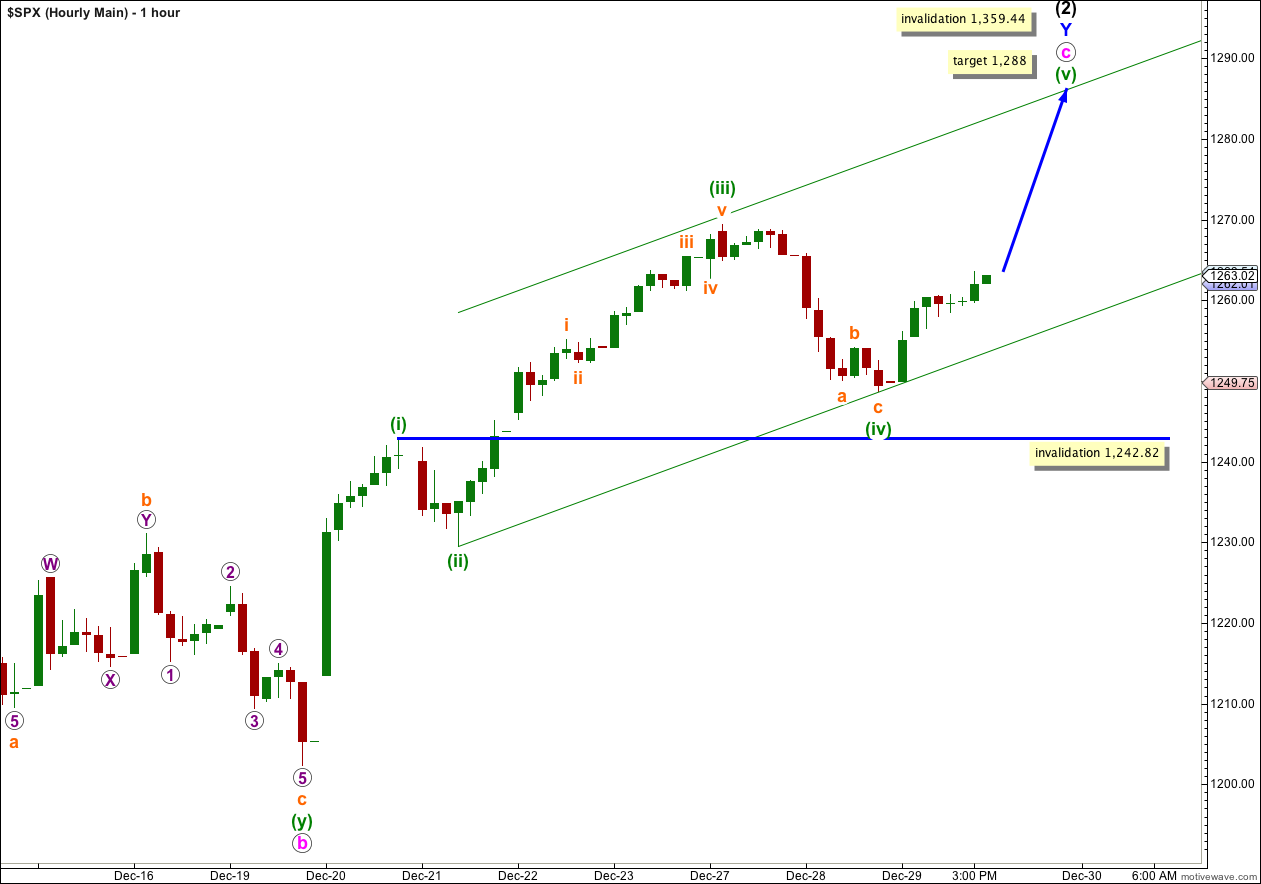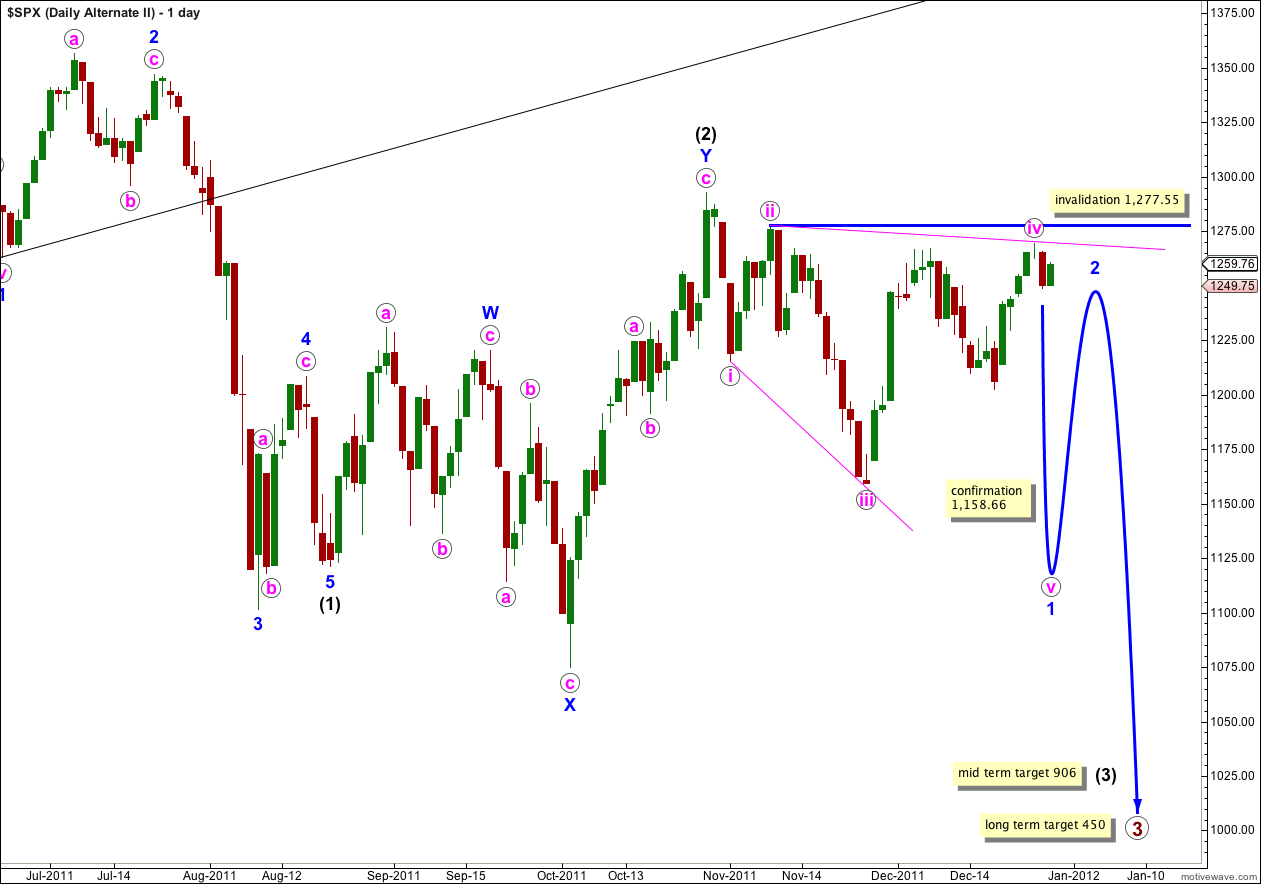Elliott Wave chart analysis for the S&P 500 for 29th December, 2011. Please click on the charts below to enlarge.
Price has continued higher as expected for Thursday’s session. Without a new high above Tuesday’s high at 1,269.37 we cannot be certain that upwards movement is the very end of wave (2) black, or a small second wave correction within the very start of wave (3) black.
The purpose of a double zigzag structure is to deepen a correction. However, this is not a rule which must be met. At this stage it looks like price will fail to reach above the high of wave W blue at 1,292.66 and wave Y blue will mostly move price sideways taking up time.
Already price has moved above the high of wave a pink at 1,267.06 and wave c pink has avoided a truncation.
The new target calculated for wave c pink to end is at 1,288.
Waves a and b pink both lasted a Fibonacci 8 days. If wave c pink continues this pattern it will continue higher for another trading session, ending on Friday 30th December.
Within wave c pink no second wave correction may move beyond the start of the first wave. This wave count is invalidated with movement below 1,202.37.
Wave (2) black may not move beyond the start of wave (1) black. This wave count is invalidated with movement above 1,359.44.
We may use Elliott’s channeling technique to draw a parallel channel about the zigzag of wave Y blue. Wave c pink may end about the upper edge of this parallel channel, or it may end mid way within the channel. When this channel is breached by downwards movement we may take that as confirmation that wave Y blue is complete and wave (3) black is underway.
So far upwards movement is in a three wave structure. If wave c pink lasts a Fibonacci 8 days then one more day of upwards movement should see this develop further into a five wave structure and most likely take price to a new high above (iii) green at 1,269.37.
Wave (iii) green was 0.59 points short of equality with wave (i) green. This means that wave (v) green is limited to no longer than equality with wave (iii) green at 1,288, because a core Elliott wave rule is the third wave may not be the shortest. 1,288 is a target and also a limit to upwards movement if the labeling of waves (i) and (iii) green are correct.
Wave (v) green may end either mid way within the channel as drawn here, or at the upper edge. When this parallel channel is breached by downwards movement then we shall have our very first indication that we may have seen a trend change.
When wave c pink is complete then wave (2) black will be a complete double zigzag structure. Doubles are relatively common structures, but triples are very rare. The probability that wave (2) black will be over and the next move will be strongly downwards will be very high indeed.
Wave (iv) green may not move into wave (i) green price territory. This wave count is invalidated with movement below 1,242.82.
When wave (v) green is a complete five wave structure then we remove this invalidation point and expect a trend change.
Our first indication that we have had a trend change will come with a breach of this parallel channel on the hourly chart. The second, stronger, confirmation of a trend change will come with price movement below 1,242.82. Final confirmation of a trend change will come with a breach of the bigger pink parallel channel on the daily chart.
Alternate Wave Count.
There are three reasons why I consider this wave count to have a very low probability:
1. Wave iv pink is already deeper than 0.81 of wave iii pink; this is the maximum common length for wave 4 within a diagonal in relation to wave 3.
2. While leading diagonals are not uncommon, leading expanding diagonals are supposedly less common structures.
3. A similar wave count on the Dow is invalidated; the Dow and S&P 500 have been moving together nicely for some time and it would be highly unusual for them to now diverge.
Within the leading diagonal for wave 1 blue wave iv pink may not move beyond the end of wave ii pink. This wave count is invalidated with movement above 1,277.55.
A leading diagonal may not have a truncated fifth wave. This wave count requires movement below 1,158.66 to remain valid.



